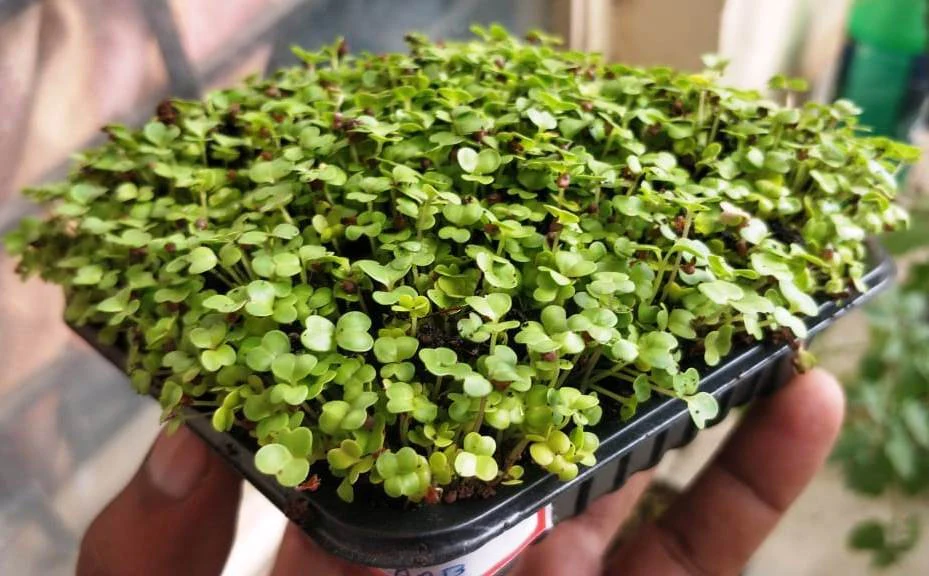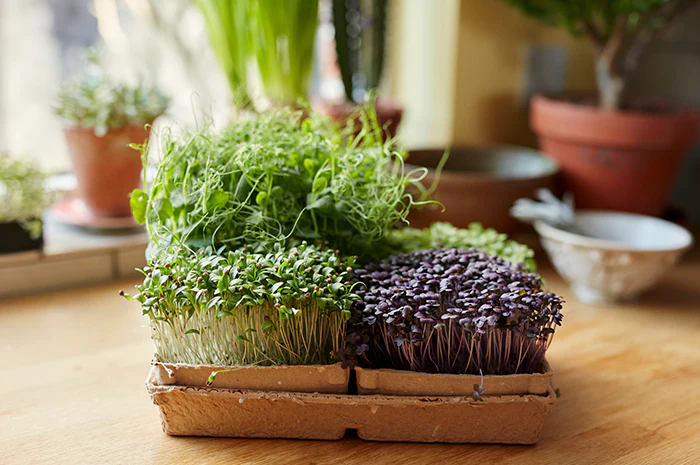If you are a health-conscious or food enthusiast, you might have heard about microgreens. These tiny greens have become quite popular in recent years and for a good reason. Not only do they add colour and texture to your meals, but they are also packed with nutrition and health benefits. This blog will cover everything you need to know about microgreens.

What are Microgreens?
Microgreens are young vegetables or herb plants harvested just a few weeks after germination. They are grown in soil or other growing media, such as coconut coir or hydroponic mats, and are harvested when they are about 1-3 inches tall. Microgreens are smaller than baby greens and larger than sprouts, and they come in a wide range of colours, textures, and flavours.
Microgreens have become increasingly popular in recent years due to their nutritional value and versatility in the kitchen. This article will examine microgreens and why they are beneficial to any diet.
Types of Microgreens
Many different types of microgreens are available, and each has its unique flavour profile and nutritional benefits. Some common types of microgreens include:
Arugula: This spicy green has a peppery taste and is high in vitamins A and C.
Broccoli: Has a mild flavour and contains nutrients, including vitamin C, calcium, and iron.
Radish: With a sharp, peppery flavour, these microgreens are high in vitamin C and antioxidants.
Cilantro: These have a fresh, citrusy flavour and are high in vitamin K.
Basil: Has a sweet, aromatic flavour and is high in vitamin A.
Mustard: These have a sharp, tangy flavour and are high in vitamins A and C.
Kale: Has a mild, nutty flavour and is high in vitamin C and calcium.
Pea shoots have a sweet, earthy flavour and are high in vitamin C and iron.
Sunflower: These have a nutty flavour and are high in vitamin E and folate.

Nutritional Value of Microgreens
Despite their small size, microgreens pack a big nutritional punch. They are high in vitamins and minerals, including vitamins C, K, and E, as well as potassium, magnesium, and iron. They are also rich in antioxidants, which help to protect your cells from damage caused by free radicals. In fact, according to a study published in the Journal of Agricultural and Food Chemistry, microgreens can contain up to 40 times more nutrients than their fully-grown counterparts. For example, red cabbage microgreens have been found to contain up to 40 times more vitamin E and six times more vitamin C than mature red cabbage.

Health Benefits of Microgreens
Microgreens are considered a superfood due to their high nutrient density. They have been linked to a wide range of health benefits, including:
Improved Digestion: Microgreens are high in fiber, which can help to promote regularity and keep your digestive system healthy.
Reduced Inflammation: The antioxidants in microgreens can help reduce inflammation in your body, which has been linked to various chronic diseases.
Improved Heart Health: Some studies have found that eating microgreens may help to lower your risk of heart disease by reducing your cholesterol levels and improving your blood pressure.
Boosted Immune System: The vitamins and minerals in microgreens can help to support your immune system and protect you from illness.
Positive Effects of Eating Microgreens
In addition to their delicious flavor and variety of colors and textures, microgreens also offer several positive health effects when consumed. Here are just a few of the benefits of eating microgreens:
High nutrient content: One of the main benefits of microgreens is their high nutrient content. They are packed with vitamins, minerals, and antioxidants, and are often richer in nutrients than their fully-grown counterparts. For example, red cabbage microgreens have been found to have 40 times more vitamin E and six times more vitamin C than fully-grown red cabbage.
Increased antioxidant intake: Many types of microgreens are high in antioxidants, which can help protect the body against free radicals and reduce the risk of chronic diseases such as cancer and heart disease.
Improved digestion: Microgreens are a good source of fiber, which can help improve digestion and prevent constipation. They are also low in calories and have a high water content, making them a hydrating and satisfying choice for those looking to support healthy digestion.
Boosted immune system: The high nutrient content of microgreens can help support a healthy immune system, helping you to stay healthy and fight off illness.

Improved cardiovascular health: Some types of microgreens, such as broccoli and kale, are high in antioxidants and nutrients that have been shown to support heart health. Consuming these types of microgreens may help lower the risk of heart disease and stroke.
Weight loss: Microgreens are low in calories and high in nutrients, making them a great choice for those looking to support weight loss efforts. They can help you feel full and satisfied, reducing the temptation to snack on unhealthy options.
Sustainable agriculture: Microgreens can be grown using less water and space than fully-grown vegetables, making them a more sustainable choice for agriculture. They can also be grown indoors, making them a convenient and sustainable choice for urban gardeners.
Ways to eat Microgreens
Microgreens are a versatile ingredient that can be incorporated into a wide range of dishes, from salads and sandwiches to soups and smoothies. Here are some ways to eat microgreens:
As a Salad: One of the most popular ways to eat microgreens is in a salad. Wash and dry the microgreens, and then add them to a bowl of mixed greens. Drizzle with your favorite dressing and enjoy!
In a Sandwich: Microgreens can also be used as a nutritious and flavorful topping for sandwiches. Add a handful of microgreens to your favorite sandwich other toppings like tomatoes, cheese, and avocado.
As a Garnish: Microgreens can be used as a beautiful and nutritious garnish for any dish. Use them to top soups, stir-fries, or even roasted vegetables for a pop of color and flavor.
In a Smoothie: Microgreens can be added to smoothies for a nutrient-packed boost. Blend them up with your favorite fruits and vegetables, and enjoy a delicious and healthy smoothie.
In a Wrap: Microgreens can be used as a tasty and nutritious filling for wraps. Spread some hummus or other spread on a tortilla, then add microgreens and other fillings like grilled chicken, roasted vegetables, or quinoa.
In a Stir-Fry: Microgreens can be used as a flavorful and nutritious addition to stir-fries. Add them to your favorite stir-fry recipe along with other vegetables and proteins.
As a Pizza Topping: Microgreens can be used as a delicious and nutritious topping for pizza. Sprinkle them over your favorite pizza recipe after baking.
Microgreens are also a great source of fiber and protein, making them a nutritious addition to any diet. They are low in calories and have a high water content, making them a great choice for those looking to add more nutrients to their diet without increasing their caloric intake.
In addition to their nutritional benefits, microgreens also add a unique and delicate flavor to dishes. They can be used as a garnish to add color and flavor to soups, sandwiches, and other dishes, or they can be added to salads for a crunchy texture and burst of flavor.
If you are interested in adding microgreens to your diet, they can be found at many specialty grocery stores or farmers markets. They can also be grown at home with minimal effort, making them a convenient and nutrient-rich addition to any meal. So, next time you are looking to add some flavor and nutrition to your dishes, consider giving microgreens a try.
(You can check out OMG's range of microgreens here! )
